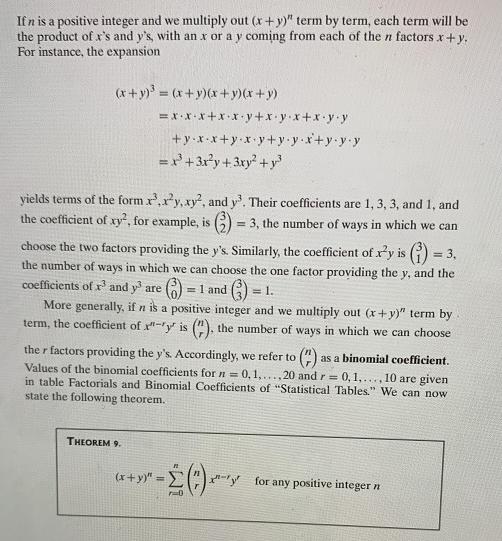Answered step by step
Verified Expert Solution
Question
1 Approved Answer
Ifn is a positive integer and we multiply out (r+y) term by term, each term will be the product of x's and y's, with


Ifn is a positive integer and we multiply out (r+y)" term by term, each term will be the product of x's and y's, with an x or a y coming from each of then factors x+y. For instance, the expansion (x+y) = (x+y)(x+y)(r +y) %3! =x.X.x+xx y+x.y.x+xy.y +y x.x+y xy+y y x+y y.y ='+3r*y+3ry +y yields terms of the form r.ry, xy, and y'. Their coefficients are 1, 3, 3, and 1, and the coefficient of xy, for example, is G) = 3, the number of ways in which we can choose the two factors providing the y's. Similarly, the coefficient of ry is G) = 3. the number of ways in which we can choose the one factor providing the y, and the coefficients of r and y are (2) =1 and () = 1. More generally, if n is a positive integer and we multiply out (x+y)" term by term, the coefficient of "-y is ("), the number of ways in which we can choose the r factors providing the y's. Accordingly, we refer to Values of the binomial coefficients for n = 0,1,...,20 and r = 0,1,..., 10 are given in table Factorials and Binomial Coefficients of "Statistical Tables." We can now as a binomial coefficient. state the following theorem. THEOREM 9. (x+y)" = py for any positive integer n 17. Show that =n2-1 by setting x = 1 in The- orem 9, then differentiating the expressions on both sides with respect to y, and finally substituting y= 1.
Step by Step Solution
★★★★★
3.43 Rating (156 Votes )
There are 3 Steps involved in it
Step: 1

Get Instant Access to Expert-Tailored Solutions
See step-by-step solutions with expert insights and AI powered tools for academic success
Step: 2

Step: 3

Document Format ( 2 attachments)
636b62c2d2b8c_243208.pdf
180 KBs PDF File
636b62c2d2b8c_243208.docx
120 KBs Word File
Ace Your Homework with AI
Get the answers you need in no time with our AI-driven, step-by-step assistance
Get Started


